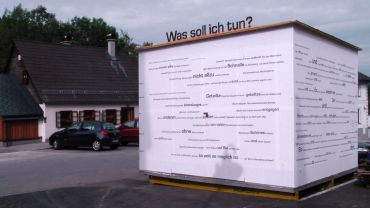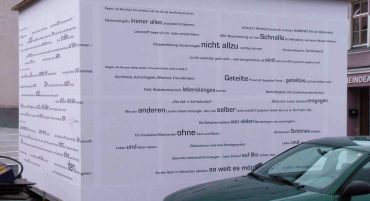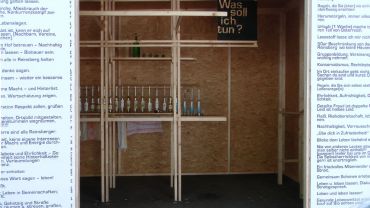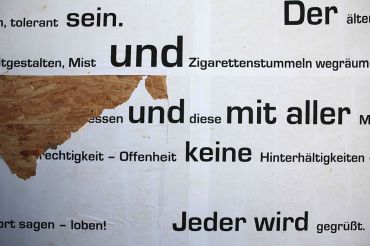2011







Mit Anna Fabricius, Michael Hieslmair / Michael Zinganel, Matthias Klos, kozek hörlonski, Antje Schiffers / Thomas Sprenger, Johanna Tinzl / Stefan Flunger, Iris Andraschek & Hubert Lobnig
Kuratiert und organisiert von Iris Andraschek und Hubert Lobnig
28. August bis 29. Oktober 2011
Die Ausstellung von Antje Schiffers und Thomas Sprenger und das Wandbild von Anna Fabricius im Kaufhaus Gruber ist jeweils Samstag von 15.00 bis 18.00 Uhr geöffnet.
2011 findet in Reinsberg zum vierten Mal ein ortsbezogenes Kunstprojekt statt. Von Iris Andraschek und Hubert Lobnig wurden 6 KünstlerInnen und Künstlerteams eingeladen, die auf unterschiedliche Weise auf örtliche Begebenheiten reagieren. Das Dorf Reinsberg mit seinen BewohnerInnen, seiner Geschichte und Geschichten, Festen, Institutionen, Organisationsformen, der Landwirtschaft, den Betrieben, dem Kindergarten, der Schule, dem Strandbad, der freiwilligen Feuerwehr, den Vereinen, der Kulturproduktion auf der Burgruine, der Produktion und Vermarktung von Bioprodukten steht zur Disposition. Die KünstlerInnen haben spezifische Arbeitsschwerpunkte und wurden präzise für Reinsberg ausgewählt. Das Projekt hat seine Basis im ehemaligen Kaufhaus Gruber im Ortskern von Reinsberg und präsentiert ab dem 27. August Projekte im öffentlichen Raum.
Geteilte Zuversicht ist ein mehrdeutiger Titel und bezieht sich auf ein spezielles Gefühl von Gegenwartswahrnehmung und Zukunftserwartung, auf den weit verbreiteten Zweifel und die große Skepsis gegenüber einer sich stets verändernden Welt. Der Titel fragt aber auch, ob Zuversicht teilbar ist.
Reinsberg hat sich seit den frühen 90er Jahren in Aufbau und der Durchführung von Kulturprojekten engagiert, die Auf- und Umwertung ihres Dorfes durch die immerwährende Erfindung neuer Images (Eisenstraße, Ötscherland, Kulturdorf) vorangetrieben. Trotzdem formierte sich in den letzten Jahren eine Bürgerliste, die Reinsberg auf den Status eines „normalen Dorfes“ zurückführen will.
Die Projekte, GETEILTE ZUVERSICHT 2011
1. Anna Fabricius „TECHNÉ“, Fotoserie 120x120cm auf 6 großformatigen Fototafeln und Kleinformate an diversen Orten. Anna Fabricius aus Budapest arbeitet seit Jahren mit unterschiedlichen Gruppen, Vereinen und Gemeinschaften. Mit einfachen fotografischen Inszenierungen versucht sie die Gruppen aus der normalen Wahrnehmung zu lösen. In den letzten Serien hat sie sich mehr und mehr von einem semidokumentarischen Blick zu einer spielerischen Umgang mit Inszenierung entwickelt. Sie stellte für „Geteilte Zuversicht“ eine Serie von Fotografien von Arbeitsgemeinschaften in Reinsberg her, in denen die Gruppen sich selbst an ihrem Arbeitsplatz inszenierten und stellt diese auf unterschiedlichen vorhandenen Displays an mehreren Orten im Dorf aus.
2. Michael Hieslmair / Michael Zinganel „NEVER WALK ALONE“, Wanderpokal und mobile Fantribüne am Sportplatz von Reinsberg. Michael Hieslmair und Michael Zinganel beziehen sich auf Gemeinschaften und Gemeinschaftsgüter in Reinsberg, auf den örtlichen Fußballverein „Hobby-Club Reinsberg“, dessen kleiner Fußballplatz im Zentrum der Gemeinde mit dem winzigen Clubhaus ein beliebter Treffpunkt ist und auf die vielen beweglichen Güter, die sich im Besitz der verschiedenen Reinsberger Vereine befinden. Die Arbeit besteht aus zwei Gaben: Der „künstlerisch überhöhte“ Wanderpokal ist mit 1,60 Meter Höhe viel zu groß, um auf einem Regal oder in einem Wohnzimmer Platz finden. Bis zum nächsten Rottenturnier im Frühjahr 2012 wird er auf dem Flachdach des Reinsberger Hobbyclub-Vereinshäuschens stehen – um dann von der jeweils siegenden Rotte zur nächsten zu wandern. Das fahrbare Tribünensegment samt Fußballfan-Utensilien und einer Lautsprecheranlage wird am Sportplatz geparkt, kann zu Auswärtsspielen mitgenommen, oder aber auch an andere Vereine verliehen werden.
3. Matthias Klos „GESCHICHTEN ERZÄHLEN SICH SELBST UND MOTIVE HABEN KEIN BENEHMEN“, Broschüre, Offsetdruck, Auflage, 500 Stück, signiert und nummeriert. Verschickt an alle Haushalte. Eingeladen zu einem Kunstprojekt im öffentlichen Raum, konstatiert der Künstler Matthias Klos die Schwierigkeit, als Außenstehender ortsbezogen zu arbeiten. Für den Ort Reinsberg schuf Matthias Klos eine kurze Erzählung über das Wirken und die Verschränkung von Alltag, Geschichten und Kulissen, deren von ihm geahnte sichtbaren Vorder- und Rückseiten er fotografisch festhielt. Text und Fotografien fügte er in einer Kleinpublikation zusammen, die an alle Haushalte der Gemeinde verteilt wurde. Eine poetische Schenkung des Künstlers im Vertrauen darauf, über Flüchtigkeit und Weitergabe Konsistenz und Verdichtung zu erzeugen. Der Inhalt der Broschüre ist im Schaufenster des ehemaligen Kaufhauses Gruber zu sehen.
4. kozek hörlonski „LGBQT“, Performance, Installation Skulptur am Parkplatz hinter dem Gasthaus Stadler (Dach, Musikheim) und Hügel am Rande des Burgruinenparkplatzes. „I wanna die in Reinsberg“ sang Oliver Hangl in seinem künstlerischen Beitrag für das Kulturdorf Reinsberg. Kozek hörlonski wiederum stellen diesen Wunsch an den Beginn ihrer Recherchen und entwickeln eine Installation, die sich mit Tod und Untergang, aber auch mit Unsichtbarkeiten auseinandersetzt. Eine Skulptur verweist auf ein Grabmal eine Kultstätte oder einen Kohlenmeiler. Grab- und Kultstätten sind die ältesten Zeugnisse menschlicher Kulturen und Zivilisation überhaupt, ihre Botschaften können aber auch brandaktuell sein. Die Installation steht eigenständig im öffentlichen Raum und wird zweimal mittels einer Performance bespielt. Die Arbeit beleuchtet Verdrängung und Tabuisierung gewisser kultureller und gesellschaftlicher Aspekte im dörflichen Zusammenleben.
5. Antje Schiffers / Thomas Sprenger „ICH BIN GERNE BAUER UND MÖCHTE ES AUCH GERNE BLEIBEN“, 18 filmische Bauernhofportraits auf DVD, 3 Monitore, 18 Fotografien auf Büttenpapier im ehemaligen Kaufhaus Gruber. Geöffnet jeden Samstag von 15.00 bis 18.00 Uhr. Seit einigen Jahren bieten Antje Schiffers und Thomas Sprenger Landwirten ein Tauschgeschäft an: ein Gemälde von ihrem Hof gegen einen Film, in dem sie, die Landwirte, ihren Betrieb und ihr Leben mit diesem Betrieb filmen. Sie waren in Niederösterreich und der Steiermark, in Holland und Wales, England und Rumänien, in der Schweiz, Deutschland und Mazedonien. Etwa eine Woche braucht Antje Schiffers für so ein Bild, und das ist die Zeit, die den Bauern für ihre Selbstdarstellung und Thomas Sprenger für das gemeinsame editieren zur Verfügung steht. Jetzt haben sie ein Archiv mit 24 Filmen über die europäische Landwirtschaft. In Reinsberg stehen 18 dieser Filme zur Auswahl bereit – sie handeln von zukunftsfähigen Modellen und der Suche nach einem Ausweg.
6. Johanna Tinzl / Stefan Flunger „EIN SCHRITT VORWÄRTS, ZWEI SCHRITTE ZURÜCK“, Uhreninstallation. Für »Geteilte Zuversicht« in Reinsberg schlugen Tinzl/Flunger eine Intervention am Kirchturm vor. Sie regten an, auf der Nordseite des Turmes, an der die Uhr fehlt eine Leiter zu installieren, die durch einen Mechanismus betrieben zu einem eigenen (auf die profane Funktion der Uhr auf dem Kirchturm hinweisenden) Zeitanzeiger generiert. 3 Stufen bewegt sich die Uhr jede Viertelstunde nach oben, zur vollen Stunde gleitet sie zurück zum Ausgangspunkt. »Ein Schritt vorwärts, zwei Schritte zurück« berührt Themenkreise des globalen Zusammenspiels zwischen Religion, Politik und Macht, die auch regional mit der Geschichte des Dorfes Reinsberg verbunden sind. Durch die momentane Unmöglichkeit einer Intervention an der Kirche lösten die KünstlerInnen das kinetische Objekt vom Kirchturm und platzierten es auf gleicher Höhe auf einen Hügel, weithin sichtbar.
7. Iris Andraschek & Hubert Lobnig „WAS SOLL ICH TUN?“ Schnapsbar im Rahmen der Reinsberger Nächte; „Invers white cube“ im Zentrum von Reinsberg. Innen und Außenraum. Iris Andraschek und Hubert Lobnig entwickeln eine Schnapsbar der Dorfethik unter dem Kant'schen Leitsatz „Was soll ich tun?“. Im Zentrum des Dorfes in das Dorffest „Reinsberger Nächte“ integriert wird ein begehbarer Kubus aufgestellt, Die Außenwände dienen als Präsentationsfläche für die Ergebnisse einer Umfrage, die die Regeln des sozialen Lebens abfragt und als Ausgangspunkt für Diskussionen über Handlungsanweisungen, die das Leben eines Dorfes bestimmen dienen soll. Welche vorgegebenen Regeln befolgen
die BewohnerInnen einer Gemeinde, welche stellen sie sich selber in einer Zeit, in der Kirche und Staat ständig an Einfluss verlieren. Der Innenraum birgt die konstruktivistische Schnapsbar, an der während des Festes klare Brände aus Reinsberg ausgeschenkt werden (reiner Geist). Nach Beendigung der Reinsberger Nächte löst der Kubus sich aus der Festarchitektur.
Präsentation der Publikation zum Projekt sowie der filmischen Dokumentation von Maria Stipsicz am Samstag, den 29.Oktober 2011, 16:00 Uhr im Gasthaus Stadler.
Mit einer Performance von kozek hörlonski.
DIVIDED CONFIDENCE A site-specific art project for Reinsberg In 2011, for the fourth time a site-specific art project took place in Reinsberg. Iris Andraschek and Hubert Lobnig invited six artists and teams of artists, who reacted to the local conditions in different ways. The entire village of Reinsberg was available for this project: the people who live there, its history and stories, its festivals, institutions, forms of organization, its farming, its businesses, the kindergarten, the school, the swimming pool, the voluntary fire service, its associations, cultural production on the castle ruins, and the production and marketing of organic foods. The artists all have their own specific interests and were especially selected for Reinsberg. The project was based in the former Gruber department store in the center of Reinsberg, and presented seven projects in public space for a period of two months. Divided Confidence is an ambiguous title that refers to a special feeling of perception of the present and expectations of the future—the widespread doubts and great skepticism toward a permanently changing world. Divided Confidence stands for the speed of incomprehensible social developments, involving the (national) states, the economy, society in general, and all the conditions that influence our individual lives: the media, global markets, border-free economic and currency zones, expansion east, migration, economic crises, etc. The title also asks, however, if confidence can be divided. Since the early 1990s, Reinsberg has been committed to setting up and implementing cultural projects, enhancing and reevaluating the village by continually creating new images, (Eisenstraße, Ötscherland, Cultural Village). By marketing regional (organic) products and building up structures (restaurants, hotel rooms, cultural walking routes, etc.) the village has successfully worked to counter the closure of companies, emigration, its subsumption under larger administrative units, and commuterization. At present the key questions are quality, size, sustainability, and economic viability, and the village is undergoing reorganization. In spite of this, in recent years a citizens’ initiative has arisen, wishing to return Reinsberg to the status of a “normal village.” Frequently, investment in art and culture is seen as a cause of economic crises, unemployment, long journeys to work, or global economic developments, although tourism is Austria is based primarily on cultural heritage and new cultural production (as well as on the Alps). Farming and fruit production are economic mainstays of this rural region. In Reinsberg there is a large proportion of organic businesses, but also a good number of conventional farms. The changing face of farming was a further point of reference for Divided Confidence: the production of foodstuffs versus the maintenance of the landscape, traditional practices versus formula farming (EU agricultural subsidies) versus old and new organic farming, and the continuous innovation of fields of business. Could it be the case that artists and farmers use very similar strategies? The selection of artists raises questions concerning the difference between the country and the city, structures of prejudice (how the people in the country see and judge the city-dweller and vice-versa). Artists who may not originally come from a city, but live and work in the city, are immediately seen as city people by villagers. Just a car registration number can lead to quick categorization.
Anna Fabricius, who comes from Budapest, has been working for some years with various groups, associations, and communities. She uses simple photographic settings in an attempt to displace these groups from their normal perception. In her recent series she has increasingly developed from a semidocumentary toward a more playful approach to staging her pictures. For Divided Confidence she created a series of photographs of working communities in Reinsberg, in which groups present themselves at their places of work. Photos of the local fire service, stage workers, footballers, workers from the paints factory, and forestry workers were exhibited at different places in the village and on six already existing poster displays, sometimes with allegorical titles.
Michael Hieslmair and Michael Zinganel referred in their work to communities and community goods in Reinsberg, specifically to the local football club, Hobbyclub Reinsberg. Their small football pitch and tiny clubhouse in the centre of the village is also a popular meeting place outside of match hours. This project also referred to the many mobile goods that are owned by various Reinsberg clubs and associations. These are often exchanged to support local events and other associations’ celebrations. This work thus consisted of two gifts to the Hobbyclub Reinsberg. The artistically exaggerated football cup is 1.6 meters high and much too large to be placed on a shelf or in a living room, and so it must be displayed in semi-public space. Until the next tournament in spring 2012 it will be on the flat roof of the small Reinsberg Hobbyclub clubhouse, in the center of the village, and then it will be passed on from one winning team to the next. The slim and mobile tribune segment, mounted on a car trailer, includes football paraphernalia for fan choreography (flags and banners in various colors) and a loudspeaker system. It is parked at the sports ground and can be taken to away games in future, or lent to other clubs.
Invited to participate in an art project in public space, artist Matthias Klos noted the difficulty an outsider has working with a specific place. The irresoluble dilemma for the artist: how to react to contexts while knowing that the complexity cannot be grasped by someone who comes from outside? In Stories Tell Themselves and Motives Have No Behavior he decided to work with the same in the same—with ambivalence within the dilemma. For Reinsberg Matthias Klos wrote a short story about the effects and the interlinking of the everyday, with its stories and backdrops, while also photographing the visible front and rear sides he guessed would fit these stories. He combined text and photos in a small publication which was sent to all the households in the village. This was a poetic gift from the artist, trusting that consistency and meaning may be produced via the ephemeral act of passing something on.
“I wanna die in Reinsberg,” Oliver Hangl sang in his artistic contribution to the Reinsberg Culture Village. kozek hörlonski also placed this desire at the start of their research and developed an installation that deals with death and decline, and also with the invisible. A sculpture reminiscent of burial mounds or charcoal stacks indicated a grave monument and a location of cult ritual, and with this burial site sculpture kozek hörlonski inscribed themselves artistically and with her private life into this village. Grave and ritual sites are the oldest witnesses to human culture and civilization we know, but their messages can be highly topical. This installation stands alone in public space and was used three times as the stage for a performance. This work highlights repression and taboos concerning specific cultural and social themes in village life.
For some years Antje Schiffers and Thomas Sprenger have been offering a swap to farmers: a painting of their farm in exchange for a film about the farmers, their business, and their lives in this business. Schiffers and Sprenger have worked in Lower Austria, in Styria, in the Netherlands, in Wales, England, and Romania, in Switzerland, Germany, and Macedonia. Antje Schiffers needs about a week to paint a pleinair picture, and during this time the farmers are available to present themeselves, to be filmed and offer comments, and often also to edit the film together with Thomas Sprenger. Whenever possible, there is also a film première and party on site. Schiffers and Sprenger now have an archive with 24 films about European farming. In Reinsberg, most of these films were shown — they look at future models and farmers searching for a way out, at business size and taking lunch, at the farmers’ relationship to the countryside, to animals, and to their families, and they show whatever the farmers themselves wanted to show and what their wish for.
For Divided Confidence in Reinsberg Tinzl/Flunger suggested an intervention on the church steeple. It is common for people to look up to the church steeple, and therefore the two artists proposed attaching a ladder on the north side of the steeple, where the clock is missing. Driven by a mechanism, this ladder would become its own timekeeper that refers to the profane function of the clock on the church steeple. Each hour this clock moves three steps up, and on the hour it slides back to its starting point. It is synchronized with the church steeple clock. “One Step Forward, Two Steps Back” touches on issues relating to the global interplay of religion, politics, and power, which are also linked to the regional history of the village of Reinsberg. Because a direct intervention on the church is at present not possible, the artists treated their kinetic object as separate from the church steeple, and placed it in a visible line with the steeple at the same height on a hill, and visible at a distance.
Iris Andraschek and Hubert Lobnig created a schnaps bar of village ethics, following the Kantian principle of “What should I do?” Integrated into the music association festival, Reinsberg Nights, Andraschek and Lobnig built a white cube whose outer walls were used as a presentation surface for the results of a survey that examined the rules of social life in Reinsberg. The sentences that had been collected and attached to the cube thus formed the starting point for a discussion on motives to behavior, and on the rules and instructions, seen as critical or desirable, that determine the life of a village. The interior space contained a “constructivist schnapsbar,” where homemade clear schnaps from Reinsberg was served during the festival. When the Reinsberg Nights came to an end, the cube was released from its function within the festival architecture, but remained standing for a while as a lawmaking body and was still used as a bar on prearranged days.
Hubert Lobnig